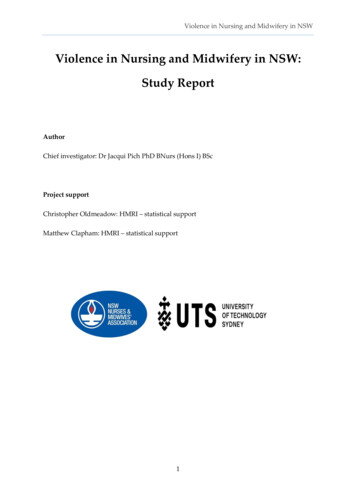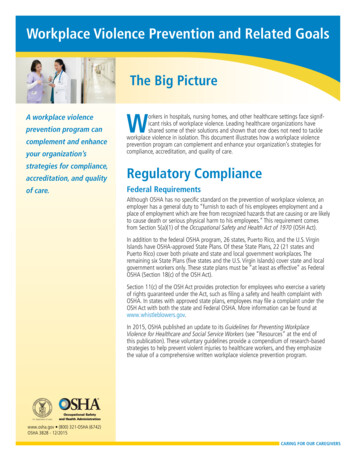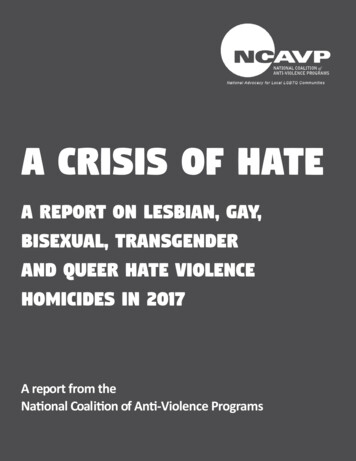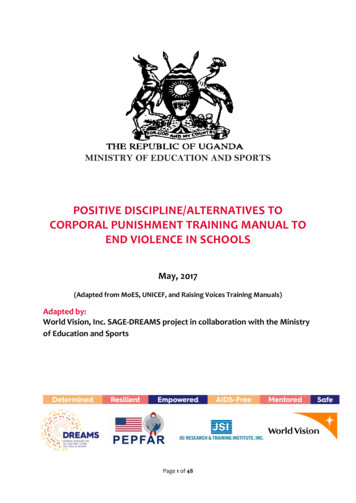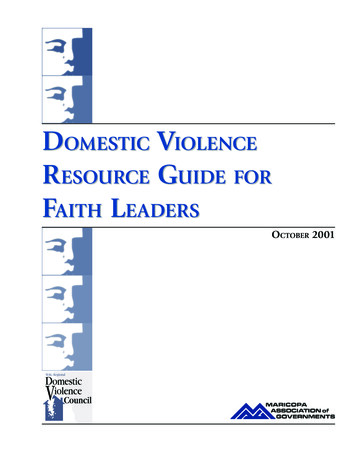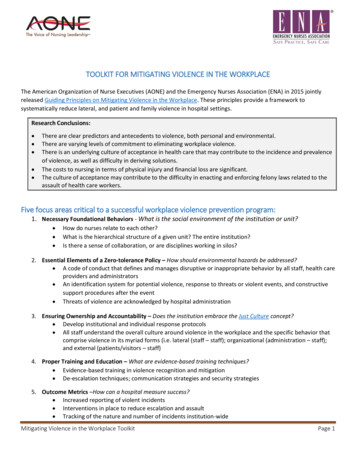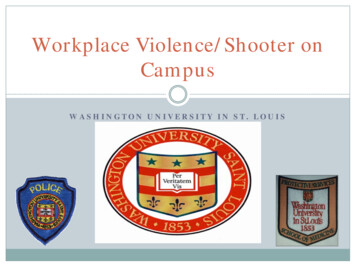
Transcription
Workplace Violence/Shooter onCampusWASHINGTON UNIVERSITY IN ST. LOUIS
Your InstructorsEric WilkinsonLife Safety Program ManagerWUSM Emergency edu ALICE Instructor
Your InstructorsLt. Mark Glenn, Washington University PoliceDepartment (WUPD) 23 years in Law EnforcementCrime Prevention/Special ProgramsMACTAC InstructorSTRATEGOS Active Shooter InstructorALICE Instructor
3 Key Objectives It can happen Anywhere, Anytime! You must Be Prepared!
FBI Stats
Incidents On The Rise
Conclusions Active Shooter incidents are becoming morefrequent. In incidents where the duration could be ascertained,70% ended in 5 minutes or less. At least 66.9% ended before police arrived and couldengage the shooter. In 21 incidents (13.1%), unarmed citizens safely andsuccessfully restrained the shooter.
What is an Active Shooter The Department of Homeland Securitydefines an active shooter as anIndividual Actively engaged in killing orattempting to kill People in a confined and populated area
Who Commits These Acts? Employees/Students Former Employees/Students Contractors/Vendors Customers/Patients/Patients’ Families Random People Men/Women/Youth In 96% of the cases analyzed, the shooter was amale and acted alone.
The FBI analyzed 154 active shooter events in the United States between2002 and 2012 (to date) that included three or more individuals being shot: A clear motivation was never determined in 40% of casesanalyzed; however, the most common identified motivationswere found to be due to: workplace retaliation (21 %), domestic disputes (14 %) academic retaliation by a current or formerstudent (7%) active shooter events most commonly occurred in aworkplace environment (37 %) or academic setting(17%).
What are some of their motives? Disgruntled toward Employer or a Person (ABB in STL) Domestic /Custody Battles, Divorce Delusional/Mental Illness (Sandy Hook Elementary/Navy Yard) Political, Religious, or Societal views (Ft. Hood/ Kirkwood) Bullying (Columbine) Humiliation/Rejection(Virginia Tech) (Santa Barbara) Loss of a job Terrorism(San Bernardino, CA)
Possible Indicators Makingverbal physical threats Unexpected mood shifts Defensive and hostile attitudes Bouts of depression Suicide threats Being obsessed with online shooter gaming. Substance abuse Radical Religious Views
Report It, It Could Save Lives If you notice a co-worker/student/etc. actingstrangely, which may include some form of verbalor physical threat against him/herself or someoneelse, it should immediately be reported.If immediate danger, contact Law Enforcement If not in immediate danger report it to a campus official(Supervisor, Human Resources, ResLife, etc.)
University of Central FloridaSummary A former UCF student who was still residing in on-campus housing was about to launch an attack onUCF. The student’s roommate called 911 after he pointeda gun at him. This 911 call and corresponding UCF Policeresponse is being credited with disrupting theassailant’s original assault plan.
Why Don’t People Report Suspicions? Becoming a target Retaliation Wrongful accusation Don’t want to get involved Refuse to believe because of personalattachment to person Gradual progression of behavior
Your Role: Be Aware Be prepared to listen to employee/studentconcerns. Listen for indicators in: Speech Look for indicators in: Email Social Media Actions of the person
Your Role: Report If Attack NOT Imminent: For Students Student Health ServicesFor employeesHuman Resources Employee Assistance Program (EAP) If Attack IS Imminent: Notify Law EnforcementProtective Services (314-362-4357) WUPD (314-935-5555) Local Law Enforcement (911)
Reasons to Protect Ourselves Majors Charles Ergenbright and Sean Hubbard NavalPostgraduate School in CA study of College/University basedActive Shooter incidents 12.5 minutes18 minutesThe development of a victim initiated mitigation system tominimize the exposure to people in the area was recommended
Develop A Survival Mindset Awareness and Preparation will giveyou an edge Develop a plan before an emergencyoccurs Train your brain and body “I will do anything to get home to my family”
Trust You/Know Your Options In An Active Shooter Emergency:– Trust your instincts– You are responsible for your own safety & survival. Options:– RUN: Can you safely escape?– HIDE: Is there a good place to hide?– FIGHT: If needed, are you prepared to defend yourself?– REPORT: Contact law enforcement.
RUN Consider where you are. Your decision to escape will be based on youranalysis of the situation. You’re there, you havethe best real time intelligence.ATTACK ZONEDANGER ZONETHREAT ZONE
RUN You will be assisting LawEnforcement by: Reducing the availability of potentialvictims Clearing the way for Law Enforcement toenter unobstructed Safety in distance
Passive vs. ProactiveLessons From28 Fatalities Room 206, 10 fatalities,2 injured. Room 211, 11 fatalities,6 injured. Room 207, 5 fatalities,6 injured.**(Barricaded only after heentered once, after that theysustained no more fatalities)Virginia Tech2 Fatalities Room 204, 2 fatalities,3 injured (Barricaded doorand jumped from a window) Room 205, 0 fatalities,0 injured (Barricaded Door)
Students at Virginia Tech sat on the floor and didn’t moveeven when the killer was in another building. Why?
If You Run, Remember Try to take others but do not let someone slow youdown. Leave your belongings if they hinder yourmovement. Tell others what is going on as you escape. Once you feel safe call: WUSM 314-362-4357WUPD 314-935-5555911 if Off Campus
What to tell the Police Location of the shooter(s). Description of the shooter(s). Weapon Description (rifle, pistol, knife) Provide clear, accurate information to authorities asquickly and safely as possible. Do Not Hang Up unless directed by dispatch, orsafety is a concern.
HIDE Shooter in the same building or blocking yourescape. Use cover and concealment to avoid shooter.ATTACK ZONEDANGER ZONETHREAT ZONE
If evacuation is not possible Lock yourself in a room or closet Barricade a door with furniture Close blinds/curtains Hide behind large objects Use other objects to hide Turn off the lights and remain quiet Turn off or silence cell phones and pagers
NIU Active Shooter Northern Illinois University is located in DeKalb, IllinoisAt 3:05 pm on February 14, 2008, Steven Kazmierczak, former NIUstudent, entered an auditorium classroom in Cole Hall with multiplefirearms and began shooting – 120 people in the roomDuring initial assault, many students hid until an unknown personyelled that the subject was reloading, many then began running andescaped24 people were shot – 5 died; an additional 3 were injured duringevacuationSuspect committed suicide as NIU police arrived on the scene
FIGHT You may encounter the shooter with no time toescape. Use Aggressive Action “Anything to Survive”mindset.ATTACK ZONEDANGER ZONETHREAT ZONE
FIGHT for Your Life Incapacitate the shooter/aggressor Be aggressive and don’t stop Use distraction techniques such as yelling/scream at theaggressor Improvise weapons: BooksFire extinguisherHot liquidsFurnitureSoda cans/BottlesStaplerScissorsChairs
Kirkwood City HallFebruary 7, 2008Thornton reached the council chambers with two weapons shortlyafter the meeting began. There, he shot a police officer, the publicworks director, two council members, the mayor, and a reporter. The City Attorney fought back by throwing chairs atThornton and thus saving his own life!
Active Shooter Exercise We need 6 audience members to participate
WUSTLAlerts University’s mass communication system Make sure that your contact info is current in HRMSeach year or as it changes The alert could come via a phone/voice message, textmessage/e-mail, outdoor warning sirens, digitalsignage, etc. Go to http://emergency.wustl.edu to verify theemergency and to find further information
Newer technology Alertus beacons Desktop pop-ups Digital signage Cable TV over-ride Indoor Public Address Social Media
What To Expect Once a credible threat is reported, a WUSTLAlertmay be sent. WUSTLAlert: “A person with a weapon has beenreported on the XYZ Campus. Go to a place that youfeel safe and remain there until further notice. Foradditional updates go to emergency.wustl.edu”
What Do I Do? If the threat is on the campus that you are currentlylocated on: RUN, HIDE, FIGHT, REPORT If you are not on the campus where the threat is,then stay away from that campus Generally, you can continue on with your routine ifyou aren’t on the affected campus, but be prepared totake action if things change
Police Response What you can expect to see It may seem like a long time but we will be there #1 priority is to stop the shooter from hurting anyone else Typical 4 officer entry teamVariations Different departments Plain clothes Weapons Injured victim response
How can you help the Police WU Weapon Policy Don’t grab at officers Keep calm Follow officer’s instructions Be prepared to be pushed down to floor or pushed away from officers or even handcuffed and searchedKeep hands out (fingers spread)DON’T POINT at officersAvoid screamingUnderstand that additional help is on the way
3 Key PointsIt Can Happen Anywhere, Anytime!If you See Something, Say Something!RUN, HIDE, FIGHT, REPORT
Resources for Faculty & StaffEmployee Assistance Program http://hr.wustl.edu/work life/Pages/EmployeeAssistanceProgram.aspxCall: 800-765-9124Student Health Services Do.aspxCall: 314-935-6666
Additional Resources www.dhs.gov/active-shooter-preparedness agement/active-shooter-incidents -preparedness/active-shooterworkplace-violence/ www.training.fema.gov/is IS – 906IS - 907
Questions
Active Shooter incidents are becoming more frequent. In incidents where the duration could be ascertained, 70% ended in 5 minutes or less. At least 66.9% ended before police arrived and could engage the shooter. In 21 incidents (13.1%), unarmed citizens safely and successfully restrained the shooter.

